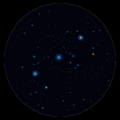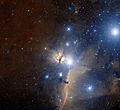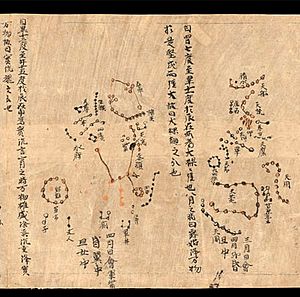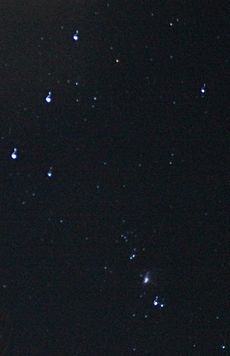Orion's Belt facts for kids
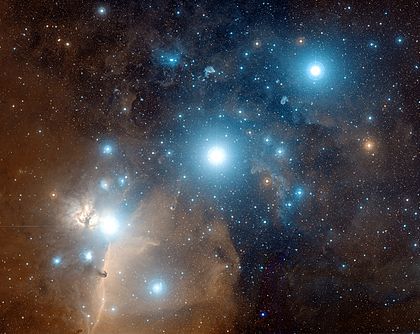
Orion's Belt, also known as the Belt of Orion, is a famous group of stars. People sometimes call it the Three Kings or Three Sisters. It's part of the Orion constellation, which looks like a hunter in the sky.
This "belt" is made up of three very bright stars: Alnitak, Alnilam, and Mintaka. They are lined up almost perfectly straight. If you want to find the Orion constellation, looking for these three stars is the easiest way! They look like the belt of the hunter's clothing. You can see them best in the early night sky during winter in the Northern Hemisphere (or summer in the Southern Hemisphere), especially in January around 9:00 pm.
Contents
Meet the Stars of Orion's Belt
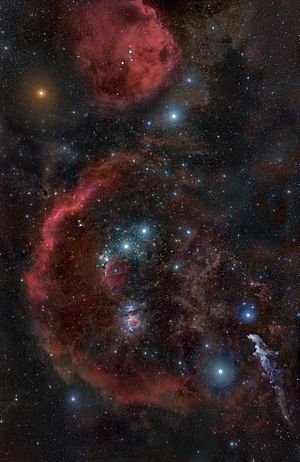
The names of these three stars come from Arabic. For example, Alnilam means "string of pearls." Mintaka and Alnitak share a similar root word, meaning "the belt."
Alnitak: The Eastern Star
Alnitak is a group of three stars, not just one! It's at the eastern end of Orion's Belt. This star system is about 1,260 light-years away from Earth. A light-year is how far light travels in one year, which is a very long distance!
The main star, Alnitak A, is a huge blue star called a supergiant. It's about 28 times bigger than our Sun. It's also the brightest star of its kind that we can see in the night sky.
Alnilam: The Bright Middle Star
Alnilam is another supergiant star. It's even farther away than Alnitak, about 2,000 light-years from Earth. This star is incredibly bright, shining 375,000 times brighter than our Sun!
Alnilam is the 29th brightest star in the entire sky. It's also the fourth brightest star in the Orion constellation.
Mintaka: The Western Star
Mintaka is about 1,200 light-years away from us. It shines very brightly, about 90,000 times more than the Sun.
Mintaka is actually a double star, meaning it's two stars orbiting around each other. They complete one orbit every 5.73 days.
Orion's Belt in Stories and Cultures
Orion's Belt has many different names and meanings in cultures around the world.
In English, some old names for the belt include Jacob's Rod, Peter's Staff, and the Golden Yard-arm. People also called them The Three Kings or The Three Marys.
The Bible even mentions Orion in the Book of Job. The poem The Princess by Alfred, Lord Tennyson, describes Orion's belt as "those three stars of the airy Giant's zone, That glitter burnished by the frosty dark."
In Portugal and South America, the stars are known as Las Tres Marías (The Three Marys) in Spanish, and "As Três Marias" in Portuguese. In the Philippines and Puerto Rico, they are called Los Tres Reyes Magos (The Three Magi). This is because the stars appear in early January, around the time of Epiphany, a Christian holiday about the Magi visiting Jesus.
In Finnish mythology, Orion's Belt is called Väinämöisen vyö (Väinämöinen's Belt). The stars that seem to hang from the belt form an asterism called Kalevanmiekka (Kaleva's sword). In ancient Scandinavia, the belt was known as Frigg's Distaff or Freyja's distaff.
The Seri people in Mexico call the three belt stars Hapj, which means a hunter. The stars represent a mule deer, a pronghorn, and a bighorn sheep. The middle star, the mule deer, is said to have been shot by the hunter.
Orion's Belt even appeared in the movie Men in Black (1997). In the movie, the characters search for "the galaxy" on Orion's Belt. They later find out the "galaxy" is actually a tiny jewel on an alien's cat, named Orion!
Gallery
-
Map of Orion
Images for kids
-
Orion's Belt and nebulosity, including the Flame Nebula (left) and Horsehead Nebula (lower left) named after a relatively small dark cloud, rotated 90° somewhat resembling a seahorse
-
The region of Alnitak and Alnilam (upper right) and the Flame Nebula
See also
 In Spanish: Cinturón de Orión para niños
In Spanish: Cinturón de Orión para niños



